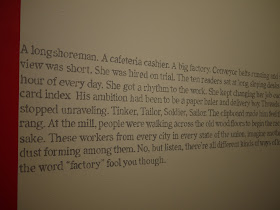A few weeks ago, in the tiny Westman Islands off the coast of Iceland I turned a corner in the local history museum in the fishing village of Heimaey and saw this poster of Led Zeppelin. I walked a little further and saw Muhammad Ali, Farah Fawcett and a beer bottle or two. Definitely things I had never seen in a local history museum before, so I made a special effort to discover what I was looking at. Literally, it stopped me in my tracks because I had never seen a period room installation like this:
This local history museum, the Byggdasafn Folk Museum, has much amazing history to tell. The story of why it's called the Westman Islands (Irish slaves escaping from their Norse captors); the invasion of Algerian pirates from the Barbery Coast; the conversion and immigration of hundreds of Mormons; and last but not least, the 1973 volcano eruption that covered the island in volcanic ash. So why Led Zeppelin?
This museum chose to tell a story about all the kinds of people who live and work here--up to the present day. This re-created space is a dorm room lived in by men who came to work in the fish factories in the 1970s and 1980s. At first when I thought about this exhibit--which also has a great label explaining how they re-created it--I thought it was important because it was about contemporary life, not just some far-distant past.
But over the last several weeks I've continued to remember this installation and to think about its meaning to my own work. Yes, this museum did a great job looking at all kinds of contemporary issues. Is fishing the most dangerous job in the world? If the video doesn't convince you, the memorial listing of fishermen running up to the present day might. But what really made me remember it?
I might keep thinking of it because it's a reminder of how reluctant many museums are to address issues of class and economics. The guys in the fishworkers dorm were working class, and not all local. The museum treated them equally. Their story was integrated into the entire story of the community, not segregated into a separate exhibit about working people. The museum just didn't tell the story of founding fathers and mothers, without any mention of hired hands, factory workers, maids or servants. Many museums have made great strides in this direction, but few do such a good job at telling an integrated story; telling the story of workers as one part of a whole community story.
And for an entirely different take on working, if you're in Western Massachusetts, check out MassMOCA's exhibit The Workers, where work by more than 40 contemporary artists encourages thought, debate, and sometimes confusion about work in today's global economy.
So who knew that spotting Led Zeppelin on a tiny Icelandic island would lead to a meditation on class and museums?









Linda,thanks for this post. I've only seen contemporary history like that at the Henry Ford Museum--a teenage girl's bedroom with a U2 poster, for example, but it didn't lead to insights into economics or class. I would love to see more examples like the one in Iceland.
ReplyDeleteThanks for commenting--it was interesting, in part because I think the idea of class was implicit, rather than explicit--but it was great to see and I'd love to see more!
ReplyDeleteI am travelling to iceland in a month and I think this would be a great way to learn about the culture there. Thanks!
ReplyDelete